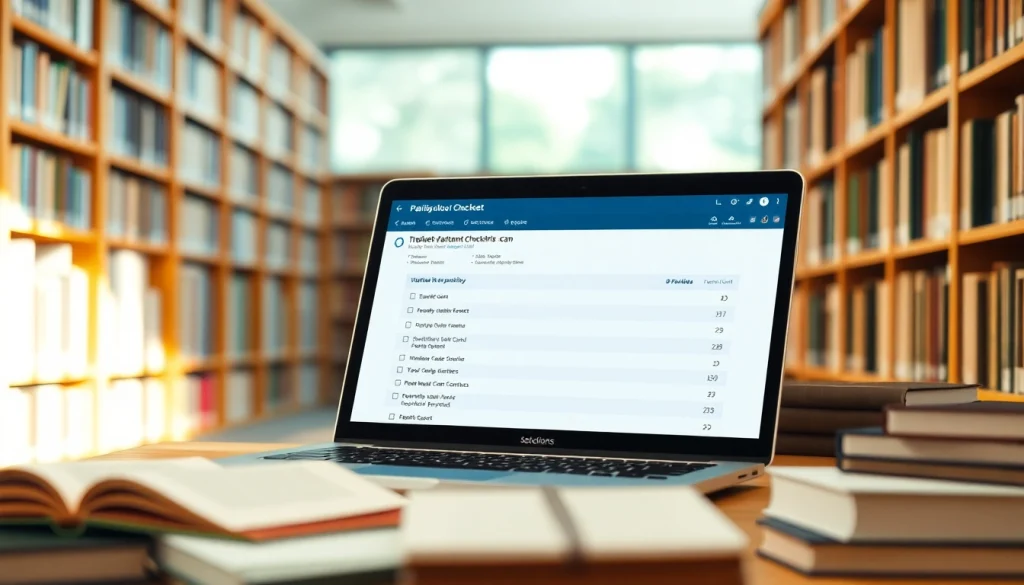Maximize Originality with an Effective Plagiarism Checker Tool

Understanding Plagiarism Checkers
What is a plagiarism checker?
A plagiarism checker is a tool designed to identify instances of plagiarism within a given text. Plagiarism, in this context, refers to the act of using someone else’s work, ideas, or expressions without proper acknowledgment or permission. These tools can range from basic software that scans for similarities across a limited set of sources to sophisticated algorithms that utilize artificial intelligence to analyze documents in-depth. By inputting your written content into a plagiarism checker, you can receive a detailed report that highlights problematic sections and provides suggestions for appropriate citations or rephrasing options.
Importance of using a plagiarism checker
The significance of utilizing a plagiarism checker cannot be overstated, especially in academic and professional settings. In education, students are expected to produce original work, and failure to do so can lead to serious penalties, including failing grades or expulsion. For content creators and professionals, originality is paramount for maintaining credibility and trust. Moreover, the increasing prevalence of digital content makes it easier to inadvertently reproduce ideas without credit. Therefore, a plagiarism checker serves as an essential safeguard that helps writers ensure their work is original and properly referenced.
How plagiarism checkers work
Plagiarism checkers analyze submitted text against a vast database of sources, which may include academic papers, articles, web pages, and other written materials. The process typically involves several steps: first, the tool breaks down the text into smaller segments or phrases, which it then compares to the data in its database. When a match is found, the tool flags it for review. Most plagiarism checkers will generate a report that not only indicates where the similarities occur but also provides the source material, thus allowing users to address the issues directly. The sophistication and accuracy of these tools can vary widely based on their underlying algorithms and the scale of their databases.
Types of Plagiarism Checkers
Online plagiarism checkers
Online plagiarism checkers are web-based tools that allow users to input text directly onto a platform for immediate analysis. These tools often have the advantage of being easily accessible and user-friendly, requiring no software download. Many offer free basic services along with premium options for more comprehensive analysis. Users can paste entire essays, articles, or any written content into an online plagiarism checker to receive instantaneous feedback on potential matches or similarities.
Software-based plagiarism checkers
Unlike online tools, software-based plagiarism checkers require downloading and installing on a device. These tools can offer more robust functionalities and a higher degree of privacy, as the documents are processed locally rather than uploaded to a remote server. They are generally favored by professionals and institutions that require enhanced security for confidential documents. Additionally, they might provide offline capabilities, allowing users to perform checks without an internet connection.
Institution-specific plagiarism checkers
Many educational institutions utilize specialized plagiarism checkers tailored to their unique needs. These systems can be seamlessly integrated into learning management systems (LMS) for easy access by students and faculty alike. Institution-specific tools often have comprehensive databases that include previous submissions made within that institution, allowing for precise comparison to detect plagiarism effectively. They may also provide additional functions, such as tracking submissions over time and offering detailed metrics on students’ writing progress.
Benefits of Regularly Using a Plagiarism Checker
Ensured academic integrity
Regularly utilizing a plagiarism checker reinforces academic integrity by promoting the importance of originality in academic writing. Students who are proactive in checking their work tend to develop good writing habits and a deeper understanding of proper citation practices. This commitment to ethical writing fosters a culture of trust within educational institutions. Moreover, ensuring the originality of their work helps students in preserving their reputations and mitigating potential conflicts related to academic dishonesty.
Improved writing skills
Using a plagiarism checker is not solely about avoiding plagiarism; it’s also a powerful educational tool. As users receive feedback on their writing, they become more adept at understanding how to paraphrase effectively and synthesize information from various sources. This continual learning process can significantly enhance their writing skills over time. Furthermore, repeated exposure to the plagiarism detection process can help writers develop a keen eye for proper citation practices and the nuances of intellectual ownership.
Time-saving in content creation
For content creators, writers, and academic professionals, time is often a precious resource. A plagiarism checker can streamline the writing process by allowing authors to identify potential issues before submission or publication. Instead of spending hours manually verifying citations or reviewing every source, writers can leverage these tools to provide quick assessments of their work’s originality. This efficiency not only improves productivity but also reduces the likelihood of last-minute revisions, creating a smoother writing and editing process.
Best Practices for Using a Plagiarism Checker
Choosing the right plagiarism checker
Not all plagiarism checkers are created equal, and selecting the right tool can significantly impact the effectiveness of the plagiarism checking process. Users should consider factors such as the size of the database, the sophistication of the detection algorithms, user reviews, ease of use, and additional features (e.g., grammar checks, citation suggestions). Professional writers and students alike may benefit from conducting thorough research to find a plagiarism checker that aligns with their needs and objectives.
Interpreting plagiarism reports
After running a document through a plagiarism checker, users receive a report that indicates any highlighted sections of text that match existing materials. Understanding how to read these reports is crucial for effective use of the tool. Reports often include a percentage score indicating the overall similarity, as well as links or references to the sources identified. Users should carefully analyze the context of matched content—sometimes matches are flagged even where proper citations are provided, so it’s vital to distinguish between cases of genuine plagiarism and acceptable use of external sources.
Avoiding common pitfalls
While plagiarism checkers are valuable tools, they are not infallible. Users should be wary of over-relying on them; a checker may miss a subtle form of plagiarism while flagging something that adheres to proper citation conventions. Additionally, writers should recognize that these tools do not replace the need for critical thinking, creativity, and proper writing techniques. Instead, they should be viewed as a supplementary resource that guides the author in refining their work while encouraging originality.
Future Trends in Plagiarism Checking Technology
AI advancements in plagiarism detection
The future of plagiarism checking technology is being shaped significantly by advancements in artificial intelligence. AI algorithms are becoming increasingly adept at not only identifying copied content but also understanding context, nuance, and the intricacies of human language. These developments will lead to more accurate and nuanced assessments of originality, as AI tools can learn from user feedback and evolve to recognize patterns of plagiarism that might go unnoticed by traditional methods.
Integration with other writing tools
There is a growing trend towards integrating plagiarism checkers with other writing and editing tools. By embedding plagiarism detection capabilities into word processors, content management systems, and educational platforms, users can receive real-time feedback while they write. This harmonization of tools will create a more seamless writing experience, allowing for instant checks of originality as part of the writing and editing workflow, which can enhance productivity and creativity.
Predictions for the plagiarism checking landscape
As technology continues to evolve, the landscape of plagiarism checking is poised for significant transformation. We can expect an increase in cross-platform functionalities, where users can seamlessly switch between devices and applications while maintaining access to their plagiarism checks. Moreover, the integration of machine learning will enhance these tools’ predictive capabilities, enabling them to provide personalized writing suggestions based on user history and preferences. Ultimately, the goal is to empower users to produce not only original work but also high-quality writing that adheres to the latest standards of academic and professional integrity, particularly through tools like plagiarism checker.







